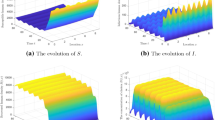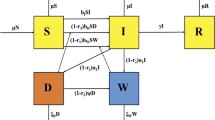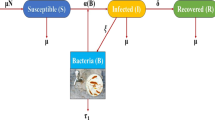Abstract
We propose a mathematical model for the transmission dynamics of some strains of the bacterium Vibrio cholerae, responsible for the cholera disease in humans. We prove that, when the basic reproduction number is equal to one, a transcritical bifurcation occurs for which the endemic equilibrium emanates from the disease-free point. A control function is introduced into the model, representing the distribution of chlorine water tablets for water purification. An optimal control problem is then proposed and analyzed, where the goal is to determine the fraction of susceptible individuals who should have access to chlorine water tablets in order to minimize the total number of new infections plus the total cost associated with the distribution of chlorine water tablets, over the considered period of time. Finally, we consider real data of the cholera outbreak in Yemen, from April 27, 2017 to April 15, 2018, choosing the values of the parameters of the uncontrolled model that fit the real data. Using our optimal control results, we show, numerically, that the distribution of chlorine water tablets could have stopped, in a fast way, the worst cholera outbreak that ever occurred in human history. Due to the critical situation of Yemen, we also simulate the case where only a small percentage of susceptible individuals has access to chlorine water tablets and obtain an optimal control solution that decreases, substantially, the maximum number of infective individuals affected by the outbreak.




Similar content being viewed by others

References
World Health Organization: Cholera (2019). http://www.who.int/news-room/fact-sheets/detail/cholera. Accessed 17 Jan 2019
Lemos-Paião, A.P., Silva, C.J., Torres, D.F.M.: An epidemic model for cholera with optimal control treatment. J. Comput. Appl. Math. 318, 168–180 (2017). https://doi.org/10.1016/j.cam.2016.11.002
World Health Organization: Weekly epidemiological record (WER), cholera vaccines. WHO position paper (2010). https://www.who.int/wer/2010/wer8513/en. Accessed 8 June 2018
Shuai, Z., Tien, J.H., van den Driessche, P.: Cholera models with hyperinfectivity and temporary immunity. Bull. Math. Biol. 74(10), 2423–2445 (2012). https://doi.org/10.1007/s11538-012-9759-4
Mwasa, A., Tchuenche, J.M.: Mathematical analysis of a cholera model with public health interventions. Biosystems 105(3), 190–200 (2011). https://doi.org/10.1016/j.biosystems.2011.04.001
Miller Neilan, R.L., Schaefer, E., Gaff, H., Fister, K.R., Lenhart, S.: Modeling optimal intervention strategies for cholera. Bull. Math. Biol. 72(8), 2004–2018 (2010). https://doi.org/10.1007/s11538-010-9521-8
Capasso, V., Paveri-Fontana, S.L.: A mathematical model for the 1973 cholera epidemic in the European Mediterranean region. Rev. Epidemiol. Santé Publique 27(2), 121–132 (1979)
Capone, F., De Cataldis, V., De Luca, R.: Influence of diffusion on the stability of equilibria in a reaction–diffusion system modeling cholera dynamic. J. Math. Biol. 71(5), 1107–1131 (2015). https://doi.org/10.1007/s00285-014-0849-9
Codeço, C.T.: Endemic and epidemic dynamics of cholera: the role of the aquatic reservoir. BMC Infect. Dis. 1(1), 14 (2001). https://doi.org/10.1186/1471-2334-1-1
Hartley, D.M., Morris Jr., J.G., Smith, D.L.: Hyperinfectivity: a critical element in the ability of V. cholerae to cause epidemics? PLoS Med. 3(1), 63–69 (2006). https://doi.org/10.1371/journal.pmed.0030007
Hove-Musekwa, S.D., Nyabadza, F., Chiyaka, C., Das, P., Tripathi, A., Mukandavire, Z.: Modelling and analysis of the effects of malnutrition in the spread of cholera. Math. Comput. Model. 53(9–10), 1583–1595 (2011). https://doi.org/10.1016/j.mcm.2010.11.060
Joh, R.I., Wang, H., Weiss, H., Weitz, J.S.: Dynamics of indirectly transmitted infectious diseases with immunological threshold. Bull. Math. Biol. 71(4), 845–862 (2009). https://doi.org/10.1007/s11538-008-9384-4
Lemos-Paião, A.P., Silva, C.J., Torres, D.F.M.: A cholera mathematical model with vaccination and the biggest outbreak of world’s history. AIMS Math. 3(4), 448–463 (2018). https://doi.org/10.3934/Math.2018.4.448
Mukandavire, Z., Mutasa, F.K., Hove-Musekwa, S.D., Dube, S., Tchuenche, J.M.: Mathematical Analysis of a Cholera Model with Carriers and Assessing the Effects of Treatment, pp. 1–37. Nova Science Publishers, Inc., New York (2008)
Pascual, M., Chaves, L.F., Cash, B., Rodó, X., Yunus, M.: Predicting endemic cholera: the role of climate variability and disease dynamics. Clim. Res. 36(2), 131–140 (2008). https://doi.org/10.3354/cr00730
Tognotti, E.: Lessons from the history of quarantine, from plague to influenza A. Emerg. Infect. Dis. 19(2), 254–259 (2013). https://doi.org/10.3201/eid1902.120312
Matovinovic, J.: A short history of quarantine (Victor C. Vaughan). Univ. Mich. Med. Cent. J. 35(4), 224–228 (1969)
Centers for Disease Control and Prevention: Quarantine and isolation (2014). http://www.cdc.gov/quarantine/historyquarantine.html. Accessed 8 June 2018
The Telegraph News: ’race against time’ to curb cholera outbreak in Yemen (2018). https://www.telegraph.co.uk/news/0/race-against-time-curb-cholera-outbreak-yemen. Accessed 8 June 2018
Wikipedia: 2016–19 Yemen cholera outbreak (2019). http://en.m.wikipedia.org/wiki/2016-18_Yemen_cholera_outbreak. Accessed 12 Oct 2019
World Health Organization: Yemen: Weekly epidemiological bulletin W15 2018 (2018). http://www.emro.who.int/images/stories/yemen/week_15.pdf?ua=1. Accessed 21 May 2018
Nishiura, H., Tsuzuki, S., Yuan, B., Yamaguchi, T., Asai, Y.: Transmission dynamics of cholera in Yemen, 2017: a real time forecasting. Theor. Biol. Med. Model. 14(1), 8 (2017). https://doi.org/10.1186/s12976-017-0061-x
Sardar, T., Mukhopadhyay, S., Bhowmick, A.R., Chattopadhyay, J.: An optimal cost effectiveness study on zimbabwe cholera seasonal data from 2008–2011. PLoS ONE 8(12), e81,231 (2013). https://doi.org/10.1371/journal.pone.0081231
Cesari, L.: Optimization—Theory and Applications, Applications of Mathematics (New York), vol. 17. Springer, New York (1983). https://doi.org/10.1007/978-1-4613-8165-5
Fleming, W.H., Rishel, R.W.: Deterministic and Stochastic Optimal Control. Springer, Berlin (1975)
Pontryagin, L.S., Boltyanskii, V.G., Gamkrelidze, R.V., Mishchenko, E.F.: The mathematical theory of optimal processes. Translated from the Russian by K. N. Trirogoff; edited by L. W. Neustadt. Interscience Publishers John Wiley & Sons, Inc. , New York, London (1962)
Osmolovskii, N.P., Maurer, H.: Applications to regular and bang-bang control. In: Advances in Design and Control, vol. 24. Society for Industrial and Applied Mathematics (SIAM), Philadelphia, PA (2012). https://doi.org/10.1137/1.9781611972368
Beretta, E., Kuang, Y.: Modeling and analysis of a marine bacteriophage infection. Math. Biosci. 149(1), 57–76 (1998). https://doi.org/10.1016/S0025-5564(97)10015-3
Siekmann, I., Malchow, H., Venturino, E.: An extension of the Beretta–Kuang model of viral diseases. Math. Biosci. Eng. 5(3), 549–565 (2008). https://doi.org/10.3934/mbe.2008.5.549
van den Driessche, P., Watmough, J.: Reproduction numbers and sub-threshold endemic equilibria for compartmental models of disease transmission. Math. Biosci. 180, 29–48 (2002). https://doi.org/10.1016/S0025-5564(02)00108-6
Diekmann, O., Heesterbeek, J.A.P., Roberts, M.G.: The construction of next-generation matrices for compartmental epidemic models. J. R. Soc. Interface 7(47), 873–885 (2010). https://doi.org/10.1098/rsif.2009.0386
Castillo-Chavez, C., Song, B.: Dynamical models of tuberculosis and their applications. Math. Biosci. Eng. 1(2), 361–404 (2004). https://doi.org/10.3934/mbe.2004.1.361
Carr, J.: Applications of Centre Manifold Theory, Applied Mathematical Sciences, vol. 35. Springer, New York (1981)
International Medical Corps UK: Emergency treatment and prevention of cholera in Yemen (2018). https://www.internationalmedicalcorps.org.uk/emergency-treatment-and-prevention-cholera-yemen. Accessed 25 May 2018
World Health Organization: Yemen: Weekly cholera bulletins
Index Mundi: Birth rate of Yemen (2018). https://www.indexmundi.com/g/g.aspx?c=ym&v=25. Accessed 6 June 2018
Index Mundi: Death rate of Yemen (2018). https://www.indexmundi.com/g/g.aspx?c=ym&v=26. Accessed 6 June 2018
Worldometers: Yemen population (2018). http://www.worldometers.info/world-population/yemen-population. Accessed 6 June 2018
Jornal de Notícias: Portugueses em Moçambique ajudam a purificar água e cortar árvores (2019). http://www.jn.pt/mundo/interior/portugueses-em-mocambique-ajudam-a-purificar-agua-e-cortar-arvores-10734255.html. Accessed 12 Oct 2019
Buonomo, B., Chitnis, N., d’Onofrio, A.: Seasonality in epidemic models: a literature review. Ric. Mat. 67(1), 7–25 (2018). https://doi.org/10.1007/s11587-017-0348-6
Pascual, M., Rodó, X., Ellner, S.P., Colwell, R., Bouma, M.J.: Cholera dynamics and el niño-southern oscillation. Science 289(5485), 1766–1769 (2000). https://doi.org/10.1126/science.289.5485.1766
Pourabbas, E., d’Onofrio, A., Rafanelli, M.: A method to estimate the incidence of communicable diseases under seasonal fluctuations with application to cholera. Appl. Math. Comput. 118(2–3), 161–174 (2001). https://doi.org/10.1016/S0096-3003(99)00212-X
Acknowledgements
This research was supported by the Portuguese Foundation for Science and Technology (FCT) within Projects UIDB/04106/2020 and UIDP/04106/2020 (CIDMA) and PTDC/EEI-AUT/2933/2014 (TOCCATA), funded by Project 3599 – Promover a Produção Científica e Desenvolvimento Tecnológico e a Constituição de Redes Temáticas and FEDER funds through COMPETE 2020, Programa Operacional Competitividade e Internacionalização (POCI). Lemos-Paião is also supported by the Ph.D. fellowship PD/BD/114184/2016; Silva by national funds (OE), through FCT, I.P., in the scope of the framework contract foreseen in the numbers 4, 5, and 6 of the article 23, of the Decree-Law 57/2016, of August 29, changed by Law 57/2017, of July 19. The research of Ezio Venturino has been partially supported by the project “Metodi numerici e computazionali per le scienze applicate” of the Dipartimento di Matematica “Giuseppe Peano”. The authors are very grateful to two anonymous referees for several constructive remarks and questions that helped them to improve the quality of the paper.
Author information
Authors and Affiliations
Corresponding author
Additional information
Communicated by Alberto d’Onofrio.
Publisher's Note
Springer Nature remains neutral with regard to jurisdictional claims in published maps and institutional affiliations.
Ezio Venturino is a member of the INdAM reseach group GNCS.
Rights and permissions
About this article
Cite this article
Lemos-Paião, A.P., Silva, C.J., Torres, D.F.M. et al. Optimal Control of Aquatic Diseases: A Case Study of Yemen’s Cholera Outbreak. J Optim Theory Appl 185, 1008–1030 (2020). https://doi.org/10.1007/s10957-020-01668-z
Received:
Accepted:
Published:
Issue Date:
DOI: https://doi.org/10.1007/s10957-020-01668-z
Keywords
- SIQRB cholera model
- Equilibrium points
- Feasibility and local stability
- Optimal control
- 2018 cholera outbreak in Yemen



